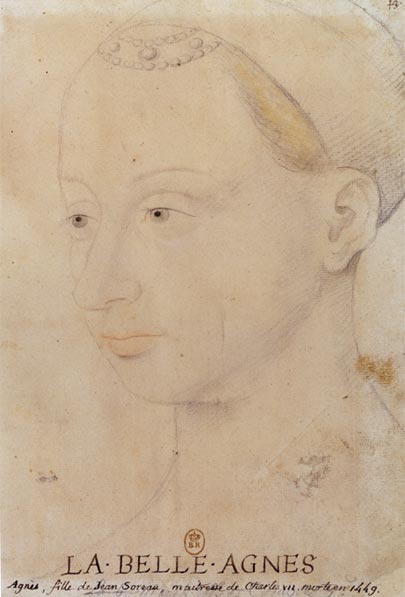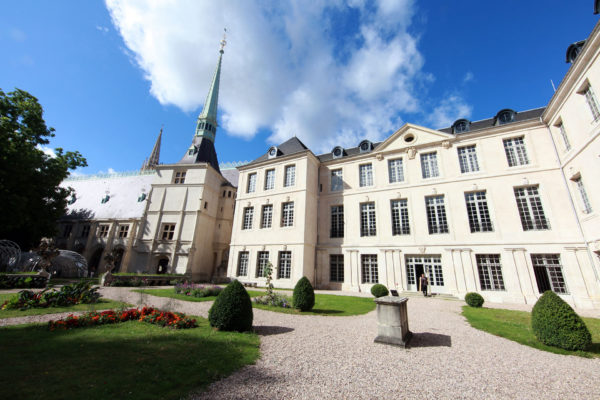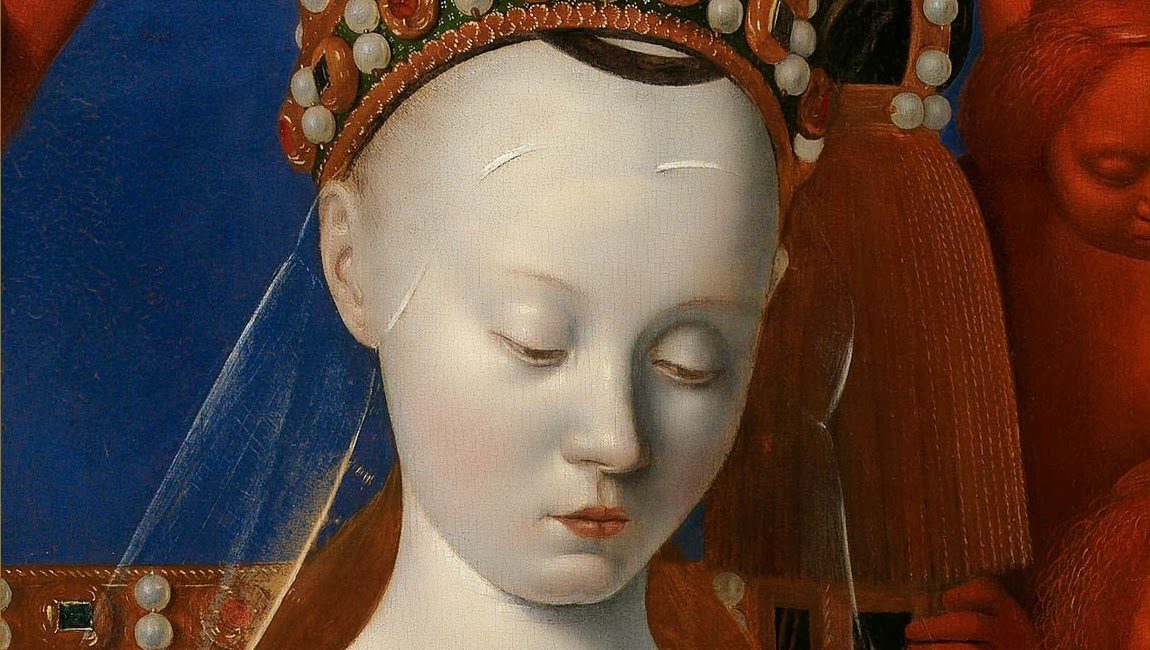Born into a provincial noble family, Agnès Sorel first took by storm the French court of King Charles VII of France in 1444 when she was aged about 20 (she was presumably born in 1422). Agnès died young under rather mysterious circumstances at the age of only 28. Her life was short, but it was also spectacular because she accomplished an unprecedented thing – she became the first titled mistress in the history of France and was loved by her royal lover, King Charles VII.

Agnès came from the family who were staunch defenders of the Valois monarchy in the region of Compiègne. Her family were local and not rich aristocrats. Nevertheless many of them, including those with surnames such as Thorole and Raineval, once participated in the Crusades. Agnès was the only daughter of Jean Sorel and his wife, Catherine de Maignelais. Jean Sorel was Lord of Coudon and Saint-Gerant, as well as advisor to the Count de Clermont. Both the Sorel and Maignelais families were strong partisans of the Valois cause during the Hundred Years’ War. Yet, as they lived in the north of France, which was at the time occupied by the Burgundians, Jean and Catherine sent their daughter to Touraine to her maternal aunt.

As a result, Agnès spent much of her childhood and adolescence in the estates of her aunt –Madame Marie de Maignelais. Her aunt loved the girl as her own child, and Agnès basked in her affection. Madame de Maignelais had her own daughter – Antoinette, born in about 1434 and twelve years younger than Agnès. Antoinette was neither pretty nor noble of character, and the only dark cloud in the firmament of Agnès’ blithesome adolescence could have been the jealousy of Antoinette to Agnès because of her cousin’s beauty and intelligence. At the time, nobody could imagine that after Agnès’ death, Antoinette would take her cousin’s place in Charles VII’s bed.
Agnès was an affectionate child, one who was called by one chronicler ‘made for love.’ She received a typical education for an aristocratic girl of the time, and it was aimed at one important goal – marriage. Agnès would have learned to embroider, to run a household, to take care of the sick and children, and to work with accounts, so she must have studied arithmetic. Women of the upper class were supposed to have certain cultural knowledge, so Agnès was taught to play musical instruments, to understand poetry and the arts, and to be knowledgeable about chivalrous romances and literature. Religious education was important for noble girls as well. Robert de Blois (an old French poet and trouvère, the author of narrative, lyric, didactic, and religious works) was also a master of etiquette, and he created an important guide in the 13th century. Agnès and Antoinette must have known it well, including rules of a polite conversation, dress, and make up.
In childhood, Agnès Sorel is described as a lovely and warm-hearted girl. As she grew up, she became a stunning beauty, whose intelligence and education were admired. Her reputation left the borders of Touraine and reached the ears of wealthy nobles. Many wanted to meet with Agnès in order to assess whether the rumors of her unique qualities were really true. Agnès had blonde hair, several shades from ash to gold; her blue almond-shaped eyes were expressive. Well-mannered and breathtakingly beautiful, Agnès had a sweet and kind nature, as well as a spirited wit. Caroline Rogers, a biographer of Charles VII of France, described this period of Agnès’ life:
“Many of the great of the land traveled to Madame de Maignelais’ Château de Fromenteau to have a look for themselves; the Duke d’Alençon and Charles de Bourbon were among the hundreds of visitors. All opinions concurred that she [Agnès] was of a beauty rarely seen.”

Madame de Maignelais did not wish her incredible niece to waste her youth in Touraine. So, she arranged for Agnès to become a lady-in-waiting to Isabella de Lorraine, suo jure Duchess of Lorraine and Queen of Naples by marriage to René d’Anjou. According to some sources, Agnès did not wish to leave her dear aunt, but she was persuaded to do so because this appointment could open many doors and create a bright future for her. In the spring of 1437, the aging Madame de Maignelais journeyed together with her charge to Nancy located in the north-eastern France; this city is formerly the capital of the Duchy of Lorraine. Duchess Isabella met Agnès with kindness, and Agnès was instructed as to her responsibilities in the duchess’ household.
Over time, Agnès became Isabella’s confidante. It was normal for France and other countries back then that noblemen would leave their parents’ houses and join a more powerful, wealthier household of more higher-ranking aristocrats to conclude their worldly education and to start their court career. Agnès was fortunate to find herself in the splendid and cultured court of Isabella de Lorraine, who was probably one of the most brilliant princesses of the era. Isabella’s husband, the Good King René, and Isabella made their grand palace a pleasant meeting place for historians, philosophers, nobility, the clergy, and European royalty. This created a myriad of opportunities for Agnès to socialize and enjoy the intellectual, joyful, and fashionable court life.

Isabella was the eldest daughter and heiress of Charles II, Duke of Lorraine and Margaret of the Palatinate. Thus, many German and other European nobles visited her court. Moreover, René d’Anjou, who was a member of the House of Valois-Anjou, was the second son of Duke Louis II d’Anjou, King of Naples, and his wife, Yolanda of Aragon. René’s birth made Lorraine a supporter of the Valois cause, and Yolande of Aragon, who was a maternal figure in Charles VII’s life, often visited her son and daughter-in-law. It seems that Yolande first met Agnès at Isabella and Rene’s palace. René and Isabella maintained such a cultured court that sculptors, troubadours, minstrels, poets, and other artists flocked to Nancy, where life was ebullient and beautiful.
Agnès spent her formative years at the Lorraine-Anjou court. Observant and clever, she must have used this time to learn how to behave at court, how to hold herself elegantly, and how to bewitch men with her beauty, style, and mind. At the time, Nancy was a cultural oasis in the midst of the war-battered French and Burgundian lands. Years later, when she would become the King of France’s mistress, Agnès would endeavor to bring the sumptuous and artistic environment like that of the Lorraine-Anjou court to the Valois court of her royal lover. In her youth, Agnès had many friends and admirers in Lorraine, as well as those who already envied her.
Despite her piety, it is unlikely that Agnès Sorel remained a virgin while in Lorraine. Strict double standards were such that women were expected to keep their virtue for their husbands, but in practice, it often did not happen. Beautiful women attracted men, and a nobleman was often bound by his masculinity to seduce them. Many female courtiers gave themselves freely to young noblemen. At courts where chivalrous and romantic ideals were cultivated, a ravishing belle often surrendered to the charms of a young knight, and this was not considered the lady’s moral plight in the eyes of others; especially not in Lorraine at the time. Thus, Agnès, who would meet King Charles VII at the age of 22, was surrounded by many temptations, and in the merry atmosphere of the Lorraine-Anjou household, she was highly likely to have an affair with some good-looking young man. After all, dozens of young women and men lived under the same roof.


The court of Lorraine was isolated from the harsh reality that reigned in the rest of France. Nonetheless, Isabella and René had connections with the French nobles, especially with Yolande of Aragon; they received news from travelers and letters. They and Agnès were aware that their happy life was surrounded by endless misery of the French who struggled against the English. At the time, there were almost no musicians, minstrels, and painters in French lands. Violence swept over the Valois realm; maladies ravaged Paris, as well as other cities, towns, and villagers. While there was no end of misery in sight for the French, Agnès lived an idyllic life in Lorraine.
All images are in the public domain.
Text © 2021 Olivia Longueville





